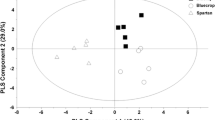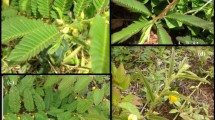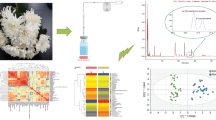Abstract
The profile of flavonoids in hops (Humulus lupulus L.) showed a significant cultivar diversity applicable for distinguishing cultivars. The aims of this study were (1) to identify and describe flavonol di- and tri-glycosides in hops; (2) to analyze the profile of flavonol glycosides in various hop cultivars; and (3) to develop a new approach for identifying hop cultivars using a manual cultivar identification diagram that consisted of the ratios between specific flavonol di- and tri-glycosides. The total of 22 different flavonol O-glucosides were detected and tentatively identified using liquid chromatography (RP-HPLC) coupled with high-resolution mass spectrometry (HR-MS/MS). The identified O-flavonol glycosides, mainly containing aglycones, quercetin, kaempferol and myricetin, were categorized into five groups according to their sugar moieties. Furthermore, fourteen characteristic peaks with a low sample-to-sample variation and acceptable coefficient of variation (< 20%) throughout growing seasons were selected for chemometric analysis. Hierarchical cluster analysis (HCA) was applied to two data sets to characterize the similarity and differences among samples: one data set contained five hop cultivars common in the Czech Republic and the second one consisted of 17 hop cultivars from around the world. The results of the HCA of flavonol di- and tri-glycosides proved the genotypic effect on their profile and allowed to select compounds primarily responsible for clustering hop cultivars into groups. These compounds were used for develo** an efficient cultivar identification strategy based on the manual cultivar identification diagram. The functionality of the identification diagram was successfully tested and allowed, based on the specific ratios between flavonol glucosides, reliable discrimination among the five most common hop cultivars planted in the Czech Republic. Compared to the genetic or chemotaxonomic methods, the newly developed approach for the hop cultivar identification provided reliable results even if the tested materials were hop pellets or beer.






Similar content being viewed by others
References
Biendl M (2009) Hops and health. Tech Q Master Brew Assoc Am 46:1–7. https://doi.org/10.1094/TQ-46-2-0416-01
Murkovic M (2003) Phenolic compounds. In: Caballero B (ed) Encyclopedia of food sciences and nutrition, 2nd edn. Academic Press, Cambridge
**ao J, Capanoglu E, Jassbi AR, Miron A (2016) Advance on the flavonoid C-glycosides and health benefits. Crit Rev Food Sci Nutr 56:29–45. https://doi.org/10.1080/10408398.2015.1067595
Bandyukova VA, Avanesov ÉT (1972) Structures of flavone and flavonol glycosides. Chem Nat Compd 4:411–423
Belitz HD, Grosch W, Schieberle P (2009) Food chemistry, 4th edn. Springer, Berlin
Aron PM, Ting PL, Shellhammer TH (2014) HPLC-ESI-MS identification of hop derived polyphenols that contribute antioxidant capacity and flavor to beer. In: Qian MC, Shellhammer TH (eds) Flavor chemistry of wine and other alcoholic beverages, 1st edn. ACS Publications, Washington
Crozier A, Jaganath IB, Clifford MN (2006) Phenols, polyphenols and tannins: an overview. In: Crozier A, Clifford MN, Ashihara H (eds) Plant secondary metabolites: occurrence, structure and role in the human diet. Blackwell Publishing Ltd., Oxford
Patzák J, Henychová A (2019) Utilization of molecular methods for hop (Humulus lupulus L.) genotype evaluation. Acta Hortic 1236:85–92. https://doi.org/10.17660/ActaHortic.2019.1236.12
Patzak J, Henychová A (2018) Evaluation of genetic variability within actual hop (Humulus lupulus L.) cultivars by an enlarged set of molecular markers. Czech J Genet Plant Breed 54:86–91. https://doi.org/10.17221/175/2016-CJGPB
Čerenak A, Jakše J, Javornik B (2003) Identification and differentiation of hop varieties using simple sequence repeat markers. J Am Soc Brew Chem 62:1–7. https://doi.org/10.1094/ASBCJ-62-0001
Mikyška A, Jurková M (2019) Varietal specificity of polyphenols, free phenolic and antioxidant potential in hops. Kvasný Průmysl 6:178–185. https://doi.org/10.18832/kp2019.65.178
Olšovská J, Krofta K, Jandovská V, Patzák J, Štěrba K (2016) Methods for verifying the authenticity of hops - an effective tool against falsification. Kvasný Průmysl 62:294–305. https://doi.org/10.18832/kp2016030
Olšovská J, Kameník Z, Čejka P, Jurková M, Mikyška A (2013) Ultra-high-performance liquid chromatography profiling method for chemical screening of proanthocyanidins in Czech hops. Talanta 15:919–926. https://doi.org/10.1016/j.talanta.2013.07.067
Vukics V, Guttman A (2010) Structural characterization of flavonoid glycosides by multi-stage mass spectrometry. Mass Spectrom Rev 29:1–16. https://doi.org/10.1002/mas.20212
Yang WZ, Qiao X, Bo T, Wang Q, Guo DA, Ye M (2014) Low energy induced homolytic fragmentation of flavonol 3-O-glycosides by negative electrospray ionization tandem mass spectrometry. Rapid Commun Mass Spectrom 4:385–395. https://doi.org/10.1002/rcm.6794
March RE, Lewars EG, Stadey ChJ, Miao XS, Zhaob X, Metcalfe ChD (2006) A comparison of flavonoid glycosides by electrospray tandem mass spectrometry. Int J Mass Spectrom 248:61–85. https://doi.org/10.1016/j.ijms.2005.09.011
Cuyckens F, Rozenberg R, de Hoffmann E, Clayes MJ (2001) Structure characterization of flavonoid O-diglycosides by positive and negative nano-electrospray ionization ion trap mass spectrometry. J Mass Spectrom 36:1203–1210. https://doi.org/10.1002/jms.224
Acknowledgements
The authors acknowledge the support of the Technology Agency of the Czech Republic within the project TE02000177 ‘Centre for Innovative Use and Strengthening of Competitiveness of Czech Brewery Raw Materials and Products’, Ministry of Agriculture of the Czech Republic within the institutional support MZE-RO1918; and Charles University within the project SVV260440.
Author information
Authors and Affiliations
Contributions
MD designed the experiments and collected the data with the help of VJ. MD wrote the manuscript draft and revised it according to the feedback of AM and VJ. All the authors approved the final version of the manuscript.
Corresponding author
Ethics declarations
Conflict of interest
The authors declare that they have no conflict of interest.
Compliance with ethics requirements
This article does not contain any studies with human participants or animals performed by any of the author.
Additional information
Publisher's Note
Springer Nature remains neutral with regard to jurisdictional claims in published maps and institutional affiliations.
Electronic supplementary material
Below is the link to the electronic supplementary material.
Rights and permissions
About this article
Cite this article
Dušek, M., Jandovská, V., Mikyška, A. et al. Novel and efficient approach to identify hop cultivars (Humulus lupulus L.) using cultivar identification diagram strategy based on fingerprint of flavonol di- and tri-O-glycosides. Eur Food Res Technol 247, 651–662 (2021). https://doi.org/10.1007/s00217-020-03653-2
Received:
Revised:
Accepted:
Published:
Issue Date:
DOI: https://doi.org/10.1007/s00217-020-03653-2




